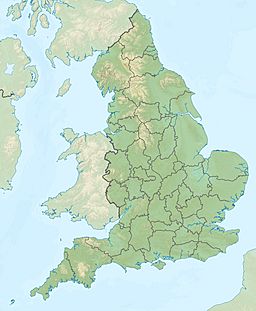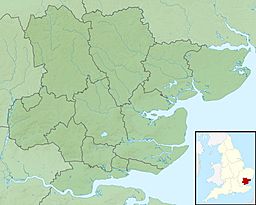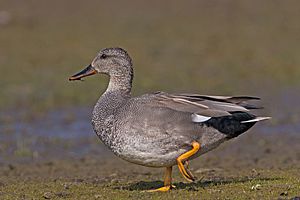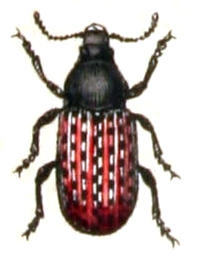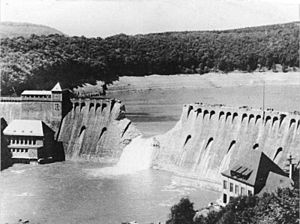Abberton Reservoir facts for kids
| Site of Special Scientific Interest | |
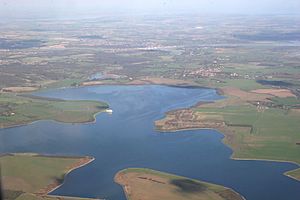
View from south-west
|
|
| Area of Search | Essex |
|---|---|
| Interest | Biological |
| Area | 700 ha (1,700 acres) |
| Notification | 1988 |
| Location map | Magic Map |
| Abberton Reservoir | |
|---|---|
| Coordinates | 51°49.2′N 00°51.6′E / 51.8200°N 0.8600°E |
| Lake type | Reservoir |
| Primary inflows | pumped from River Stour and River Great Ouse |
| Managing agency | Essex and Suffolk Water |
| Built | 1939 |
| Surface area | 700 ha (1,700 acres) |
| Max. depth | 17 m (56 ft) |
| Water volume | 41,000 megalitres (9.0×109 imp gal) |
| Designated: | 24 July 1981 |
| Reference #: | 220 |
Abberton Reservoir is a huge freshwater reservoir in eastern England, close to the Essex coast. It's the biggest freshwater area in Essex and the fourth largest reservoir in England. It covers about 700 hectares (1,700 acres).
This reservoir is a "pumped storage" type. This means water is pumped into it from rivers like the River Stour. Abberton Reservoir is located about 6 km (3.7 mi) southwest of Colchester, near the village of Layer de la Haye.
It is owned and managed by Essex and Suffolk Water. In 2013, the reservoir was made even bigger. Its capacity was increased to 41,000 megalitres (9.0×109 imp gal) by making its banks taller.
Abberton Reservoir is super important for birds. Many cormorants breed here, and lots of waterfowl spend the winter or moult (shed feathers) here. It's also a stop for migrating birds. Because of its importance, it's a special protected area called a Ramsar site, a Site of Special Scientific Interest, and a Special Protection Area.
During World War II, the reservoir was used for secret training. The famous 617 Squadron ("The Dam Busters") practiced their bombing runs here for attacks on German dams.
Contents
History of Abberton Reservoir
Abberton Reservoir was built between 1935 and 1939. It was created to provide water for the people of Essex. The reservoir was made by building a dam across the Layer Brook.
Most of its water comes from the River Stour, which is about 14 km (8.7 mi) away. The dam wall is made of earth and has a special clay core to stop water from leaking. When it was first built, the reservoir held 25,000 megalitres (5.5×109 imp gal) of water.
Making the Reservoir Bigger
Over time, more water was needed in the area. So, the owners, Essex and Suffolk Water, started a big project to make the reservoir larger. Between 2010 and 2013, they spent £140 million to increase its size by 58%. This meant raising the banks of the reservoir.
Now, Abberton Reservoir can hold 41,000 megalitres (9.0×109 imp gal) of water. This project also allowed water from the River Great Ouse (which is 141 km (88 mi) away!) to be brought to the reservoir. New pipelines were built to connect these rivers and Abberton.
Sections of the Reservoir
The reservoir covers about 700 ha (1,700 acres) and is divided into three parts. These parts are separated by causeways (raised roads) called Layer Breton and Layer de la Haye.
- The Main section is the largest, covering 535 ha (1,320 acres).
- The Central section is 49 ha (120 acres).
- The Western section is 16 ha (40 acres).
The deepest part of the reservoir is now about 17 m (56 ft) deep.
Nature and Wildlife
The areas around Abberton Reservoir are very important for nature. The Western and Central sections have natural shores with plants like common reed and willow trees. These areas also have damp grasslands and fields.
The Main part of the reservoir used to have concrete edges. But during the expansion project (2010-2013), about 12 kilometres (7.5 mi) of this concrete was removed. The edges were reshaped to make them better for water birds. Now, about 200 hectares (490 acres) of the area is managed by Suffolk Water and the Essex Wildlife Trust. Their goal is to increase biodiversity, which means having a wider variety of plants and animals.
The new design created small pools around the reservoir's edges. It also allowed for the creation of marshland (wet, grassy areas) in the western part. A culvert (a tunnel for water) under the Layer de la Haye causeway was blocked. This means the water level in the western sections can be kept separate from the main reservoir. This helps create different habitats for wildlife.
Birds at Abberton
Abberton is a fantastic place for birds!
- Cormorants: Since the 1950s, cormorants have used Abberton as a winter roosting (sleeping) site. In 1981, it became the first place in England where they nested in trees.
- Egrets: Little egrets started nesting here in 2014, and cattle egrets bred here in 2020.
- Other Breeding Birds: You can find Cetti's warblers and nightingales. Farmland birds like corn bunting, yellowhammer, and barn owls also breed in the protected areas. Small birds called little ringed plovers nest on the reshaped edges of the reservoir.
Abberton is a major spot for birds that spend the winter here. It usually has about 35,000 individual birds, but this can go up to over 40,000 in very cold winters.
- International Importance: It's super important for wintering gadwall, shoveler, and wigeon.
- National Importance: It's also important for mute swans, teal, pochard, tufted ducks, goldeneyes, coots, and great crested grebes. Many ducks also moult (shed their feathers) here.
- Waders: In winter, you can see many waders (birds that wade in shallow water), like black-tailed godwits, ruff, lapwings, and golden plovers.
- Birds of Prey: European bitterns are often seen in the western part of the reservoir in winter. Birds of prey like hen harriers, merlins, peregrine falcons, and marsh harriers hunt over the grasslands nearby.
Because it's close to the coast, Abberton sometimes gets rarer birds like smew and long-tailed duck. Very rare birds have also been spotted, including Britain's first canvasback (1997–2001)!
Bird Ringing Scheme
Abberton has had a bird ringing scheme for over 70 years. This is where small, numbered rings are placed on birds' legs to track them. Over 90,000 ducks have been ringed here, including 40,000 teal. By tracking these birds, scientists have learned how long some species can live. For example, a wigeon lived for 34 years, a pochard for 22 years, and a gadwall for 21 years!
Other Wildlife
Besides birds, Abberton is home to other cool animals:
- Mammals: You might spot otters, water voles, brown hares, and eight different kinds of bats.
- Reptiles and Amphibians: Common lizards, grass snakes, and great crested newts also live here.
- Insects: There are even rare weevils (a type of beetle), like Rhynchites auratus and Anthribus fasciatus.
Protection of Abberton Reservoir
Abberton Reservoir is a very important place for nature, so it has several special protections:
- Special Protection Area (SPA): It was named an SPA in 1991. This is because of the large numbers of golden plovers, gadwalls, shovelers, and teal that spend the winter here. It's also important for its breeding cormorants.
- Site of Special Scientific Interest (SSSI): This means it's a site of national importance for its wildlife or geology.
- Ramsar Site: It's an internationally important wetland (a wet land area).
- Nature Conservation Review: It's listed in this review, which highlights the most important sites for nature in Britain.
A small part of the site is managed by the Essex Wildlife Trust, a charity that protects wildlife.
Abberton Reservoir in World War II
Abberton Reservoir was filled just before World War II began. The Ministry of Defence was worried that German seaplanes might use it as a landing spot if they invaded. To stop this, 312 naval mines were placed in a grid pattern across the reservoir. These mines were anchored by steel cables. Steel cables were also stretched across the part of the reservoir closest to the pumping station to protect the building. Some mines accidentally exploded due to ice, but most were safely detonated by soldiers after the war.
The Dam Busters' Training Ground
The reservoir became a secret training ground for the RAF's famous 617 Squadron, known as "The Dam Busters." They used Abberton to practice for their daring mission to bomb German dams in the Ruhr region (called Operation Chastise). Abberton Reservoir was chosen because it looked similar to the Eder Dam in Germany.
Lancaster bombers, fitted with special bouncing bombs designed by Barnes Wallis, were used in these trials. Military police would close the causeway (the road across the reservoir) while the practice runs took place. The last full practice flight for the Ruhr attack happened on the night of May 14, 1943. The actual attack on the German dams took place just two nights later, on May 16, 1943.
Visiting Abberton Reservoir
The Essex Wildlife Trust has a car park and a nature reserve at the north end of the Layer de la Haye causeway.
- Visitor Centre: There's a visitor centre with a shop, a café, toilets, and a play area.
- Bird Hides: You can use three bird hides (small buildings for watching birds without disturbing them). Two hides look over the Main section, and one is in the woodland.
- Opening Hours: The visitor centre and reserve are open from 9:30 am to 4:00 pm, Thursday to Monday, all year round.
You can also view the Western and Central sections from the Layer Breton and Layer de la Haye causeways. The Layer de la Haye causeway also gives you views of the Main section. There isn't public access to the Western section. However, a car park at the southern end of the Layer de la Haye causeway leads to a viewing screen and special areas called scrapes (shallow dips for birds' nests) for waders on the Main Section. You can also see parts of the Main section from public footpaths and St Andrews Church in Abberton village.
Images for kids


